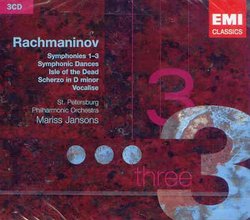| All Artists: Sergey Rachmaninov, Mariss Jansons, St. Petersburg Philharmonic Orchestra Title: Rachmaninov: Symphonies 1-3, Symphonic Dances; Isle of the Dead; Scherzo in D Members Wishing: 0 Total Copies: 0 Label: EMI Classics Original Release Date: 1/1/2007 Re-Release Date: 10/2/2007 Genres: Dance & Electronic, Classical Styles: Forms & Genres, Theatrical, Incidental & Program Music, Historical Periods, Modern, 20th, & 21st Century, Symphonies Number of Discs: 3 SwapaCD Credits: 3 UPCs: 400000001647, 5099950088522 |
Search - Sergey Rachmaninov, Mariss Jansons, St. Petersburg Philharmonic Orchestra :: Rachmaninov: Symphonies 1-3, Symphonic Dances; Isle of the Dead; Scherzo in D
 | Sergey Rachmaninov, Mariss Jansons, St. Petersburg Philharmonic Orchestra Rachmaninov: Symphonies 1-3, Symphonic Dances; Isle of the Dead; Scherzo in D Genres: Dance & Electronic, Classical
3 CD SET JANSONS/ST. PETERSBURG PO |
Larger Image |
CD DetailsSynopsis
Product Description 3 CD SET JANSONS/ST. PETERSBURG PO Similarly Requested CDs
|
CD ReviewsThe Best Symphony Value in the Catalog? Doug - Haydn Fan | California | 07/31/2008 (5 out of 5 stars) "For reasons that make no sense Amazon is offering these superb performances by Jansons of the complete Rachmaninov symphonies at rock bottom pricing. Included are that splendid and masterful late work, The Symphonic Dances. As an extra bonus EMI adds that darkest and most morbid of tone poems, "The Isle of the Dead". All this for a little over a dozen dollars! This has been accomplished without any overlapping of the symphonies from one to the next. In our new petro-barter economy, this works out to less than a gallon a symphony! Jansons gives an exciting, quite forward presentation of the less popular 1st symphony. I have long been in a small minority that enjoy this piece, despite its admitted repetitiousness. The huge fanfare setting the stage may never be lived up to in this work, but it does set the table for the works to come. The far superior 2nd symphony deserves an outstanding performance, and Jansons delivers, with an almost Haitink-like control, presenting the entire musical architecture in razor sharp focus. So vital and important is the 2nd in any complete set of the Rachmnainoff symphonies that had this version not been a top rendition even the bargain basement give-a-way price would not have induced me to recommend this package. No worry with the Third, either, another excellent example, and very well-recorded. The other works included are equally well done. I prefer them to versions by Previn, whose reputation in Rachmaninov I do not wholly share, and Ashkenazy, who never produces the beautiful bell tones he could as a pianist when he leads an orchestra. (This is apparently his attention, but I dislike the gritty tones and harshness in Rachmaninov, and have taken to labeling the ex-pianist 'Vlad the Impaler' for running roughshod over Rachmaninov's beautiful lyricism and delightfully colorful orchestrations.) The dark shadows engulfing all these works are only relieved when illuminated by sudden intense fragments of color, like stained glass windows in a Russian Orthodox church that burst into miraculous display when the sun comes out on a winter's day. The Symphonic Dances will always belong to the Philadelphia Orchestra - but this is another glorious version of this fabulous music, and no poor cousin in Janson's echt Russian delivery. (Anyone looking without success can find the Sybaritic Philadelphians Symphonic Dances on a budget Sony potpourri Ballet Music by Offenbach, Rachmaninov, & Smetana) All in all - if you haven't yet picked up any Rachmaninov this is your big chance. Highest possible rating! " Superb and a great value Martin R. Lash | Sister Bay, Wisc | 12/08/2007 (5 out of 5 stars) "EMI has issued this set as 3 CD's for the price of one. Its a great value and Jansons' conducting of the 3 symphonies is superb. The second is particularly dramatic. You also get the wonderful and dark Isle of the Dead and the composer's Symphonic Dances. At this price it can't be beat. Rachmaninov fans need not hesitate." Very Russian performances at super-bargain price -- unmissa Santa Fe Listener | Santa Fe, NM USA | 04/11/2008 (5 out of 5 stars) "Scanning the growing catalog in EMI's "Triplet" series, certain releases jump out, and this is certainly one. Jansons has a family conneciton to the St. Petersburg Phil., since his father, Arvids Jansons, was picked by the great Yevgeny Mravinsky to be his assistant in 1946 when Mariss was three (the orchestra was then the Leningrad Phil., of course). Now that the son is far more famous internationally than the father, it's odd that he has made so few recordings with his famil;y orchestra, so to speak.
This set of Rachmaninov symphonies represents the best of them, highly praised when they first appeared beginning in the late Eighties. Each symphony is as accomplished as the other -- musicians and conductor have this idiom in their bones. EMI's recorded sound has lots of visceral impact (they seemed to do better with their Russian venue at the time than, say, Philips was doing for Gergiev). Casual listeners will probably not be interested in the sprawling and uninspired Sym. #1, but everything else here is prime, ultra lush Rachmaninov, and at a three-for-one price, one can hardly argue. In all, it would be hard to find an integral set of the Rachmaninov symphonies (not forgetting the late Symphonic Dances) to equal Jansons' versions." |

 Track Listings (5) - Disc #1
Track Listings (5) - Disc #1








![Bizet: Carmen / Jessye Norman, Freni, Shicoff, Estes, Le Roux; Ozawa [Highlights]](https://nationalbookswap.com/cd//m/87/0887/6020887.jpg)